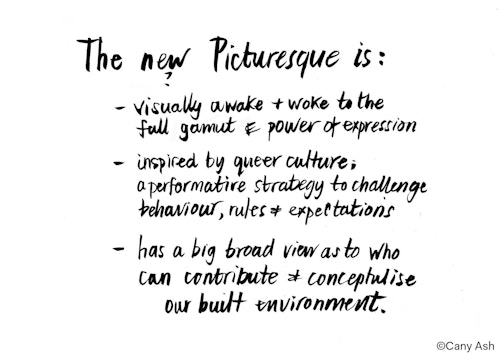/ Citymakers - Pragmatics of The Picturesque: Observations on the Picturesque
How does the picturesque rise above its flawed history and remain useful or has the time come to cast it aside?
The closing session of the 2021 Citymakers sought to widen the conversation about the picturesque, bringing together four architectural historians who, through different angles, illustrate the broad range of picturesque antecedents through the 19th and into the 20th century and across geographies. Widening the discussion further still, three key responders, all practitioners, provide their reflections, examinations and challenges of the picturesque in implementing principles into practice.
Dr Emily Mann, lecturer at the Courtauld Institute of Art, takes us through a chequered history of the picturesque, noting how fluid and loosely defined the term was, to the point, some claimed, of being virtually meaningless. She recalls the various critiques waged against the picturesque, positing that in this obscurity it created a freedom to retrieve from the ruins those fragments of use and cast the rest aside. Drawing attention to the curiously aligned trajectories of the use of the words ‘empire’ and ‘picturesque’ during the 19th century, Emily reveals the picturesque’s entanglement with empire and its use as a tool for imperial expansion, by rendering far distant lands, familiar, in the process, disguising repression.
Dr Dirk van den Heuvel, Associate Professor at TU Delft, explains how the work of Alison and Peter Smithson, the British architects often associated with Brutalism and a sense of the rational, is unexpectedly immersed in the picturesque. Describing how the pair employed picturesque design strategies, their ideas for a new shape of community, and their belief in the new reenergising of the old created a valuable reciprocity between a pre-modern urban fabric and a new modern architecture.
Dr Otto Saumarez Smith, Assistant Professor at the University of Warwick, discusses a variety of urban planners and architects during the 1950s and 1960s who demonstrated the picturesque could be applied to an urban condition. Their use of picturesque strategies ranged from defining ‘Englishness’ and making modernism palatable in a historic setting to using the concept as a tool to fight ongoing suburbanisation.
Dr Divya Subramanian, Lecturer at Columbia University, argues that by ‘provincialising’ the picturesque – a notion, she points out, which might seem unnecessary for the already sentimental concept – we can emphasise its particularity and incompleteness in a global arena, without discounting its use as a strategy for the contemporary city. Divya takes us through Gordon Cullen’s lesser-known work in Delhi, the idea of decentering the picturesque, concluding that perhaps the provincial quality is not a weakness, but rather one of its greatest strengths.
Bringing a different perspective, three key listeners offer their own reflections on the picturesque. Rashid bin Shabib, urbanist and curator based in Dubai and co-founder of Brownbook, reflects on the importance of nature in sustaining communities and what it means for the natural world to be our client. Cany Ash, partner at Ash Sakula Architects, a socially driven practice producing remarkable and inventive projects, presents her idea of the ‘new picturesque’. William Mann founding partner of Witherford Watson Mann, concludes with an eloquent reflection on how the picturesque might offer a framework for making a city with multiple logics.

